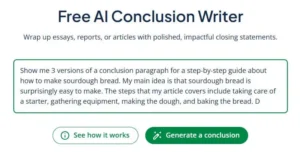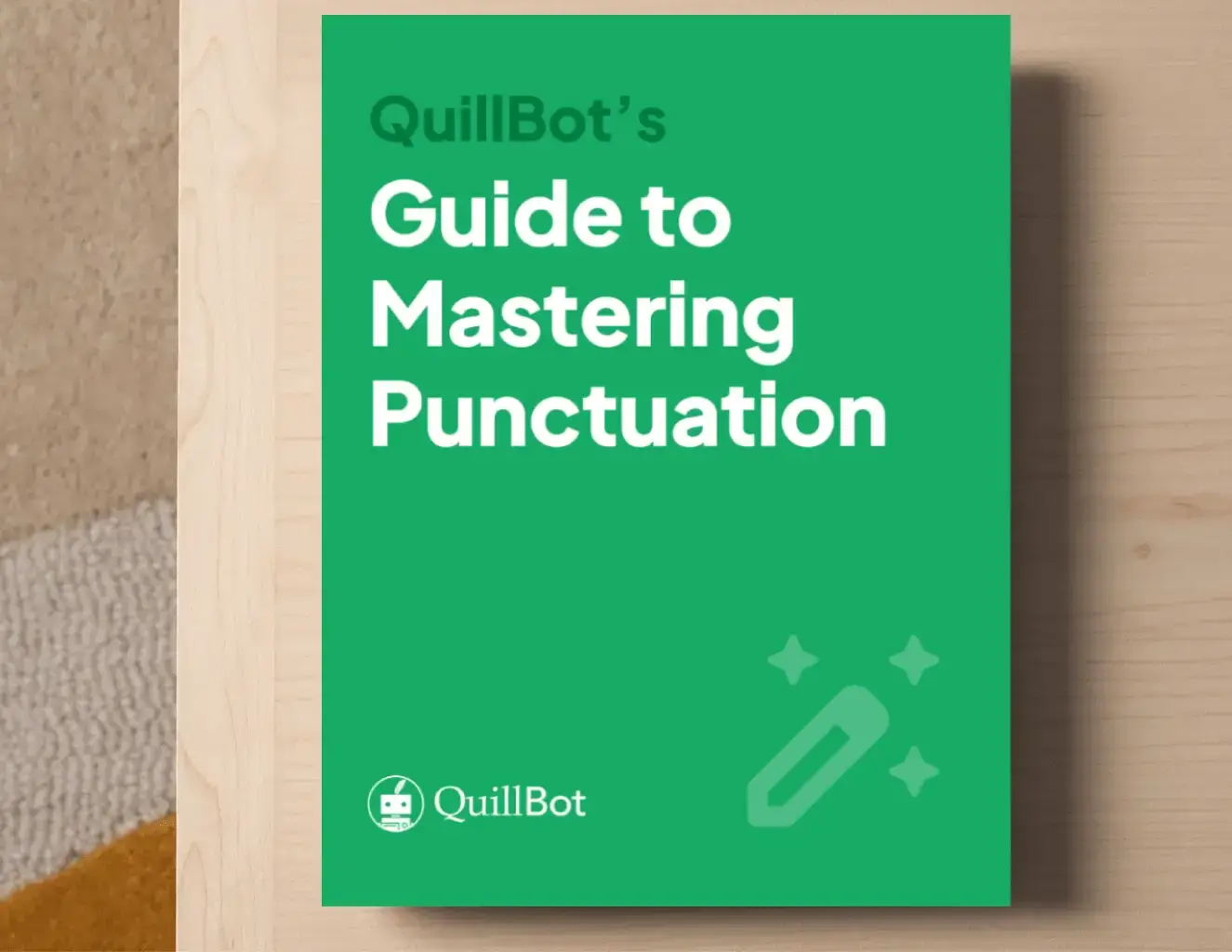How to Write a Conclusion | Tips & Examples
Whether you’re writing an essay, report, or letter, a strong conclusion leaves your readers with closure and makes your ideas more memorable.
To write a conclusion, remind readers of your main idea or main purpose, explain how all of your main points are connected, and end with a final insight or call to action.
The tips and examples below show how to write a conclusion for different types of writing.
QuillBot’s free AI conclusion writer can also streamline the process.
Conclusion paragraph outline
A focused and organized conclusion paragraph is vital to the success of many types of writing. In most cases, a conclusion paragraph follows a 3-step outline.
- Paraphrase your main idea.
- Explain how your main points are connected.
- End with a final insight or call to action.
Each of these steps looks a little different depending on what you’re writing. The details that follow show how to tailor each step to different types of writing.
1. Paraphrase your main idea
To start a conclusion, paraphrase the single main idea that ties your whole document together. Your conclusion should reiterate the same main idea from your introduction but with different words. The main idea varies depending on what you’re writing. Here are some common variations.
- Academic essay: Your essay’s main focus, purpose, or argument
- Cover letter: Your strong potential and/or enthusiasm for a job you’re applying for
- Personal statement: Your ability to excel in the academic program you’re pursuing
- Letter of recommendation: Your professional opinion about the person you’re recommending
- Business report: The conclusion you’ve drawn about the business strategy or work-related phenomenon you’ve explored
- Business proposal: Your argument about the investment, project, partnership, etc. that you want your readers to help you pursue
2. Explain how your main points are connected
Next, explain how the main points that you’ve developed in the body paragraphs are all connected to your main idea. (In most cases, your main points are the topics of your body paragraphs.) To write this part of a conclusion, ask yourself:
- Which key points have I developed in the body paragraphs?
- How do they all fit together to make my main idea valid, convincing, or worthy of attention?
Avoid bringing up new points of discussion or supporting details. If you find yourself doing so, consider which body paragraphs should have those details instead.
- Three low-cost, easy ways to reduce stress are box breathing, gratitude lists, and aromatherapy.
- Box breathing, gratitude journaling, and aromatherapy significantly improve the body’s stress response, and all of these techniques involve little-to-no cost and a minimal time commitment. Because of their ease and accessibility, these techniques may be even more effective than expensive alternatives.
3. End with a final insight or call to action
The last part of a conclusion provides final insight or suggests a future action. In business and career writing (e.g., a cover letter or project proposal), the last sentence is usually a call to action about what you want to happen next. For example, you might tell the reader to contact you for an interview or email you to set up a meeting about the next steps.
A call to action also works well in some essays (e.g., arguments), which might also end with an insightful statement about the topic’s broader implications or significance.
How to start a conclusion paragraph
Some techniques work better than others at the beginning of a conclusion paragraph.
To start a conclusion paragraph, rephrase your main idea in a way that’s different from your introduction paragraph or thesis statement. For example, you might use a different sentence structure or arrange the ideas in a different order. Here are a few pitfalls to avoid:
- Avoid generic conclusion paragraph starters, like “in conclusion” and “in closing,” which sound stiff and state the obvious.
- Don’t phrase your main idea in the same way as your introduction paragraph.
- Avoid referring directly to “this letter” or “this essay” (e.g., “This essay has proven that daylight savings is no longer necessary in the modern world”).
How to write a conclusion for an essay
Essays tend to be complex and full of detail, so an organized conclusion paragraph is especially helpful to readers. To write a conclusion for an essay, follow these three steps.
- Paraphrase the thesis statement from your introduction paragraph.
- Explain how your main points or body paragraph topics are connected.
- End with a final insight about the broader implications of your topic.
The chart below shows some common ways to approach these three steps in different types of essays.
| Argument essay | Literary analysis | Compare/contrast | |
| Step 1 | Paraphrase your main argument. | Reiterate the author’s main theme or purpose. | Remind readers of the main purpose or context for the comparison. |
| Step 2 | Explain how the reasons (i.e., body paragraph topics) work together to support the main argument. | Explain how the literary device(s) analyzed in the body paragraphs support the theme/purpose. | Summarize the differences and similarities that were described in the body paragraphs. |
| Step 3 | Motivate the reader to stay informed about the issue or take a specific action. | State the larger benefit of analyzing literature related to this author, text, genre, or historical period. | State the larger benefit of knowing about the similarities/differences. |
Conclusion paragraph examples
The two examples below show how to write a conclusion paragraph that rephrases the main idea, ties all the points together, and ends with a final action or insight. The first example is a conclusion for a letter of recommendation:
Maria is precisely the type of empathic leader that our K–12 classrooms need, and she will thrive as a first-year teacher at Clarke County High School. Her tireless work ethic and deep insights about teaching and learning have substantially raised the bar for her classmates, and her enthusiasm for literature has already made a huge impact on the 10th grade learners whom she taught during preservice teaching. If you need additional details about Maria’s teaching qualifications, please don’t hesitate to reach out.
In this next example for a rhetorical analysis essay, the conclusion recaps the emotional appeals that make an author’s argument successful.
Montgomery’s book provides a fascinating exploration of octopus intelligence and effectively convinces readers that captivity is unethical. The success of Montgomery’s argument is the direct result of her strategic and creative use of the three rhetorical appeals. Whereas the personal anecdotes establish her credibility, the scientific facts and vivid descriptions engage readers on both a cognitive and emotional level. By emulating Montgomery’s engaging and thorough writing style, biologists and researchers could significantly improve how humans study and interact with other living creatures.
How to use a conclusion paragraph generator
When you’re working on a tight deadline or need a creative boost, QuillBot’s AI conclusion writer can accelerate the conclusion-writing process. The following tips will help you get the most out of this tool.
- Write a clear prompt: On the tool’s landing page, type specific details about your topic, main idea, and body paragraph topics or main points. (You can also copy/paste the rest of your draft into the prompt.)
- Ask for multiple variations: Ask for multiple variations so that you can choose one that best fits your style and your goals. For example, you might instruct the tool to provide 3 variations of your cover letter conclusion.
- Revise the output: Especially if you’re writing an academic assignment for a grade, your conclusion should reflect your own writing voice and effort. Review the output to make sure it aligns with the rest of your draft, and adjust the wording and ideas as needed.
QuillBot’s AI conclusion writer
Frequently asked questions about how to write a conclusion
- How do you write a conclusion for an argumentative essay?
-
Follow these steps to write a conclusion for an argumentative essay:
- Paraphrase your main argument (but avoid repeating your thesis statement word for word).
- Explain how your reasons/lines of argument (aka the topics of your body paragraphs) work together to prove your main argument.
- End with a final insight about your topic, implications for the future, or a call to action.
QuillBot’s free AI conclusion writer can instantly draft a conclusion if you include your draft in the prompt. From there, you can adjust words and phrases to match your writing voice and main argument.
- How do I write a conclusion for a rhetorical analysis?
-
To write a conclusion for a rhetorical analysis essay, follow these steps:
- Remind readers of the author’s overall purpose or main argument.
- State whether the author’s text was effective or ineffective overall.
- Explain how the rhetorical modes(ethos, pathos, and logos) or rhetorical devices work together to enhance or weaken the author’s argument.
- End with a final insight about why the author’s text is worth evaluating.
Have you tried QuillBot’s free AI conclusion writer? If you include your introduction and body paragraphs in the prompt, it can instantly draft a conclusion, which you can then modify as needed.
- What should a strong conclusion in a literary analysis always include?
-
A strong conclusion in a literary analysis includes this information:
- A reminder of the author’s main theme or purpose.
- A summary of how the literary devices or techniques that you analyzed in your body paragraphs are connected to the author’s theme.
- A final insight about how the text enhances readers’ understanding about a particular topic or theme.
One way to speed up the process is by using QuillBot’s free AI conclusion writer to show you a sample conclusion, which you can then adjust to match the goals of your analysis.
- What is the purpose of a cover letter conclusion?
-
The purpose of a cover letter conclusion is to restate your claim about why you’re a great fit, reiterate your enthusiasm, and motivate the reader to contact you for an interview.
Your cover letter conclusion should leave a positive impression so that the recruiter or hiring manager is excited to review your resume.
To maximize the purpose of a cover letter, always proofread before you send it to employers. QuillBot’s free Grammar Checker instantly finds and fixes errors.
Cite this Quillbot article
We encourage the use of reliable sources in all types of writing. You can copy and paste the citation or click the "Cite this article" button to automatically add it to our free Citation Generator.
Routh, N. (2025, October 21). How to Write a Conclusion | Tips & Examples. Quillbot. Retrieved November 19, 2025, from https://quillbot.com/blog/academic-writing/how-to-write-a-conclusion/


